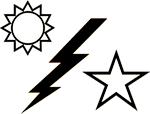- Grid location of the pickup site
(6-grid minimum)
- Radio frequency and call sign
(so medevac can call you back)
- Number of patients by precedence
a. Urgent
b. Priority
c. Routine
- Special Equipment
a. None
b. Hoist
c. Extraction equipment
d. Ventilator
- Number of patients by type
L. Littler
A. Ambulatory
----Above is the minimum to launch the bird----
- Security of pick up site
N. No enemy
P. Possible enemy
E. Enemy in area
X. Escort required
- Method of marking
a. Panels
b. Pyro signal
c. Smoke signal
d. None
e. Other
- Patient Nationality
a. US Military
b. US Civilian
c. Non US Military
d. Non US Civilian
e. EPW
- NBC(wartime)/Terrain Feature(peacetime)
a. Nuclear
b. Biological
c. Chemical
